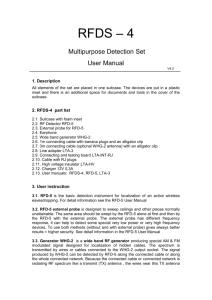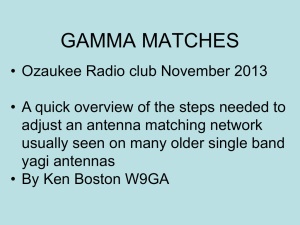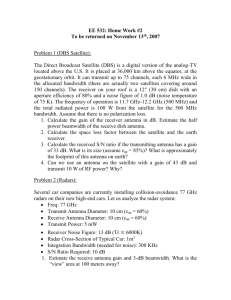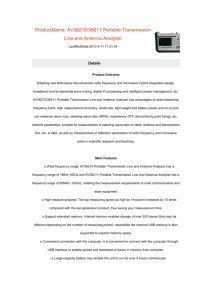Introduction to Wireless Networks
advertisement
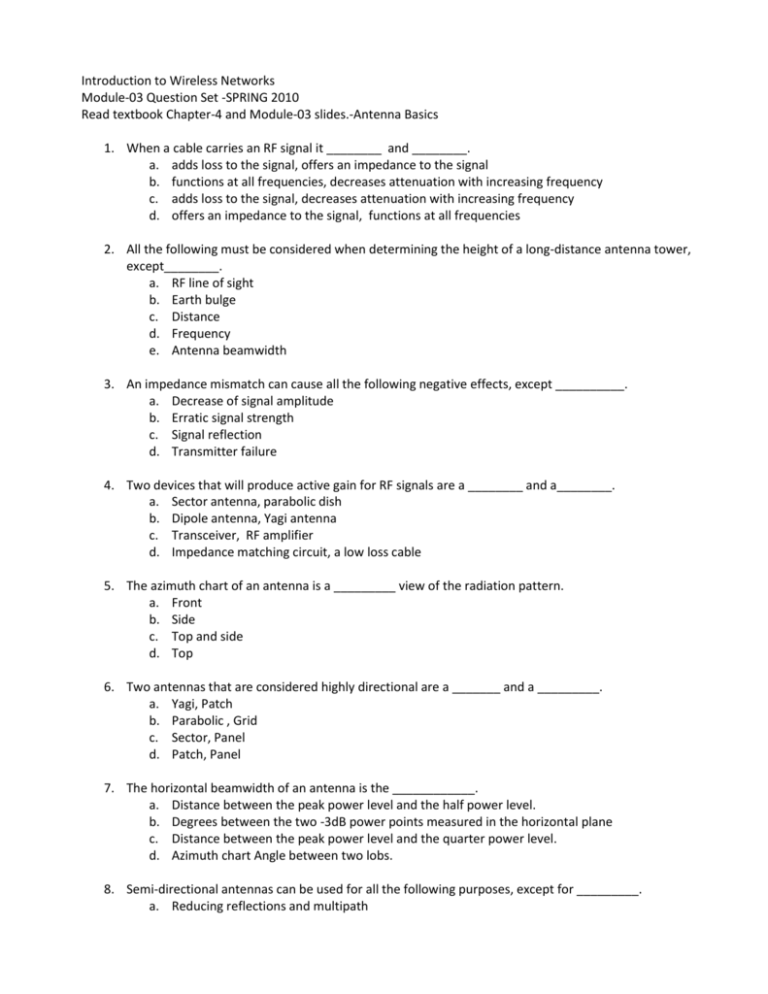
Introduction to Wireless Networks Module-03 Question Set -SPRING 2010 Read textbook Chapter-4 and Module-03 slides.-Antenna Basics 1. When a cable carries an RF signal it ________ and ________. a. adds loss to the signal, offers an impedance to the signal b. functions at all frequencies, decreases attenuation with increasing frequency c. adds loss to the signal, decreases attenuation with increasing frequency d. offers an impedance to the signal, functions at all frequencies 2. All the following must be considered when determining the height of a long-distance antenna tower, except________. a. RF line of sight b. Earth bulge c. Distance d. Frequency e. Antenna beamwidth 3. An impedance mismatch can cause all the following negative effects, except __________. a. Decrease of signal amplitude b. Erratic signal strength c. Signal reflection d. Transmitter failure 4. Two devices that will produce active gain for RF signals are a ________ and a________. a. Sector antenna, parabolic dish b. Dipole antenna, Yagi antenna c. Transceiver, RF amplifier d. Impedance matching circuit, a low loss cable 5. The azimuth chart of an antenna is a _________ view of the radiation pattern. a. Front b. Side c. Top and side d. Top 6. Two antennas that are considered highly directional are a _______ and a _________. a. Yagi, Patch b. Parabolic , Grid c. Sector, Panel d. Patch, Panel 7. The horizontal beamwidth of an antenna is the ____________. a. Distance between the peak power level and the half power level. b. Degrees between the two -3dB power points measured in the horizontal plane c. Distance between the peak power level and the quarter power level. d. Azimuth chart Angle between two lobs. 8. Semi-directional antennas can be used for all the following purposes, except for _________. a. Reducing reflections and multipath b. Providing unidirectional coverage for indoor applications c. Providing short-distance point-to-point RF communications d. Providing long-distance point-to-point RF communications 9. To establish a 4-mile point-to-point link at 2.4 GHz you must consider ________ and _______. a. The choice of a high gain antenna, the 40 percent or less Fresnel zone blockage b. The earths bulge, choice of semi-directional antenna c. The earths bulge, Choice of a high gain antenna d. The impedance mismatch, choice of semi-directional antenna 10. Lightning arrestors will protect against _______. a. Power surges b. Improper grounding c. Direct lightning strikes d. Transient currents from nearby lightning strikes 11. Blocking the Fresnel zone by more than ________ can produce unreliable communications. a. 60% b. 50% c. 40% d. 20% 12. The size of the Fresnel zone (based upon the formula) is determined by ________ and _________. a. Antenna beamwidth, RF line of sight b. Distance, frequency c. Half power beamwidth, frequency d. RF line of site, distance 13. The bulge of the earth should be considered for point-to-point links greater than ________. a. 30 miles b. 10 miles c. 7 miles d. 5 miles 14. After replacing a water damaged antenna cable, the network administrator determines that the EIRP now exceeds the regulated power limit. This could be due to _________ or to _________. a. Installing a short cable, installing a higher grade cable b. Installing a longer cable, installing a higher grade cable c. Installing a cable with reflections, installing a shorter cable d. Installing a higher grade cable, installing a cable with reflections 15. Transceivers that employ antenna diversity sample the signal from two or more antennas and selects _______. When the transceiver transmits it transmits using ________. a. the weakest signal, strongest signal antenna b. the weakest signal, weakest signal antenna c. the strongest signal, all antennas d. the strongest signal, strongest signal antenna 16. The antenna cable signal ratio between the maximum peak voltage and the minimum peak voltage is the ________. a. b. c. d. Voltage Signal wave ratio Return loss Voltage signal peak ratio Voltage standing wave ratio 17. The signal between the transceiver and the antenna can be reduced by all the following except _____. a. Using a cheaper cable b. Shortening the cable length c. Increasing the cable length d. Adding and attenuator 18. Rotating an antenna during installation the signal peaks, then drops and then increases a bit. The last increase is due to the ________. a. Main lobe secondary effect b. Half power beamwidth c. Side band d. Side lobe 19. The recommended usable range of VSWR is ________. a. 1.5 : 1 to 5.0 : 1 b. 15.1 : 1 to 1.5 : 1 c. 1.1 : 1 to 1.5 : 1 d. 5.0 : 1 to 1.1 : 1 20. Return loss is the ___________. a. VSWR in db b. Ratio of the reflective voltage to the transmitted voltage in db c. Maximum voltage minus the minimum voltage in db d. Ratio of the main lobe to the back lobe 21. The second Fresnel zone is _________ and ________ . a. Smaller than the first zone, in phase with the point source b. Larger than the first zone, out of phase with the point source c. Smaller than the first zone, out of phase with the point source d. Larger than the first zone, is a harmonic of the first zone frequency 22. Antenna amplifiers can be purchased with all the following characteristics, except _________ a. Unidirectional amplification b. Bidirectional amplification c. Variable frequency and gain d. Fixed gain 23. The property of antenna that states that transmitting and receiving patterns are the same is _____. a. Symmetry b. Reciprocity c. Conservation of energy d. Transitivity 24. A main lobe of a 21 dBi antenna has ______ signal gain than a dipole. a. 18.86 dB more b. 21.14 db more c. 2.14 dB less d. 23.14 dB more 25. A wireless LAN network requires maximizing a signal in a large room and minimizing a signal beyond the walls of the room. An engineer suggests using a __________ antenna on a wall. a. Wall mounted Yagi b. Diversity patch wall mount c. Wall mounted Omni-directional d. Pillar mounted diversity

